The Origins of Ikebana Floral Art, Part 1: Early History

In the second installment of our series on ikebana, we offer a brief overview of the early history of ikebana. Rokkakudo Temple in Kyoto, considered the birthplace of ikebana, is also the headquarters of the Ikenobo School. Its museum offers precious insights into the history of ikebana floral art.
Early History of Ikebana
1. The Spiritual Roots of Ikebana
2. Rokkakudo Temple in Kyoto: The Birthplace of Ikebana
3. Ikebana in the Muromachi Period (1336-1573)
4. Ikebana in the Late 16th Century
Today's Ikebana
The Spiritual Roots of Ikebana
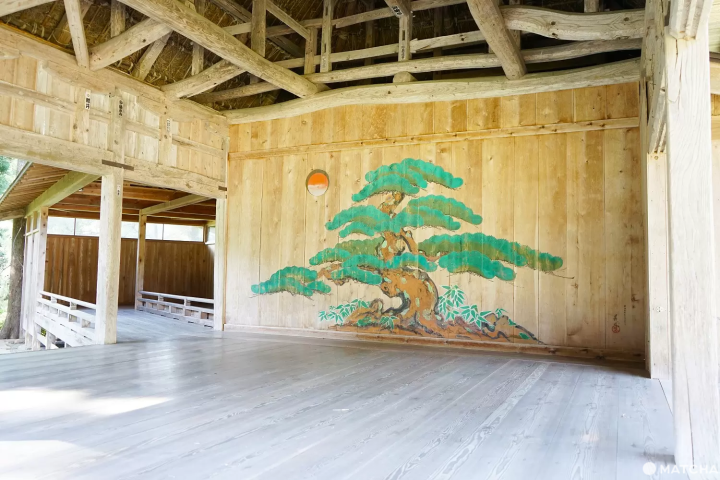
The pine tree image on the back of every stage for Noh theater signifies the presence of a deity and is a good example of yorishiro. Daizen Shrine on Sado Island
The history of ikebana as an art with a philosophy and methodology dates back to the mid-15th century (*1), but its origins can be traced much earlier.
Nature lies at the center of Shinto, the native spirituality of Japan. In the Shinto worldview, trees sometimes act as yorishiro—objects used by deities to descend into the world. Trees that are several centuries old are often considered sacred (shinboku) and seen as the homes of deities.
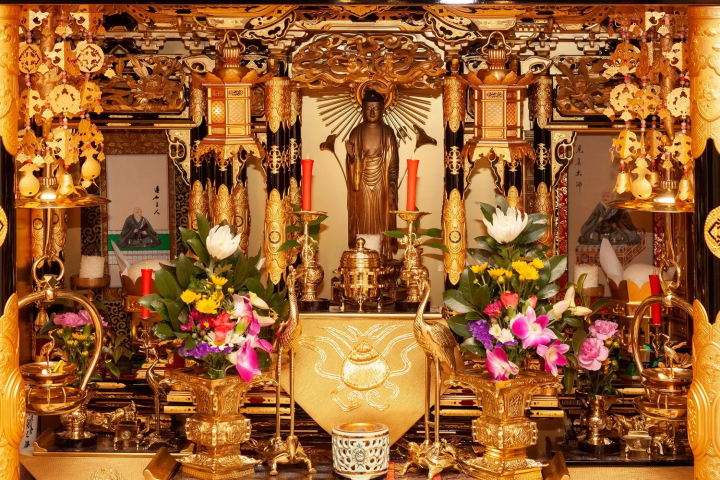
A Buddhist altar. Photo by Pixta
On the other hand, the Buddhist practice of offering flowers along with prayers at temple altars has existed in Japan since Buddhism began to spread here in the early 6th century.
Ikebana and its aesthetics are deeply connected to Japanese spirituality. For those who practice it, it is a way to experience a worldview that is nature-centered rather than man-centered.
Below, I introduce a brief overview of the history of ikebana and its development.
Rokkakudo Temple in Kyoto: The Birthplace of Ikebana
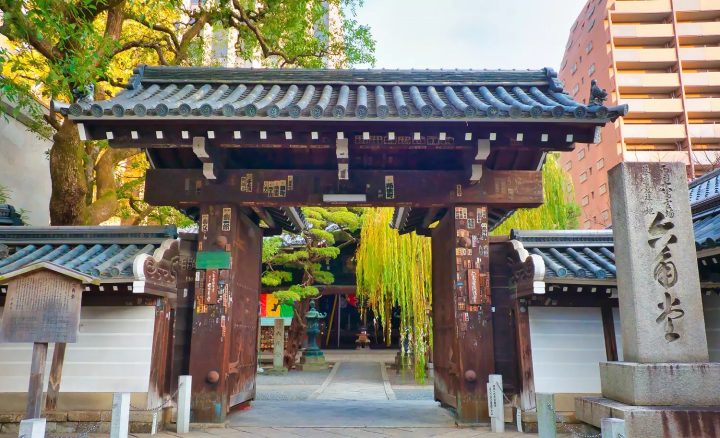
Photo by Pixta
In the center of Kyoto, just a 3-minute walk from exit 5 of Karasuma Oike Station, you can find Rokkakudo Temple, which is considered the birthplace of ikebana.
Rokkakudo Temple is said to have been founded in 587 (*2). Temple legends attribute its founding to Prince Shotoku (574-622), a regent, scholar, and influential politician of the Asuka period (538-710), who created Japan's first constitution and was an early promoter of Buddhism in the country.
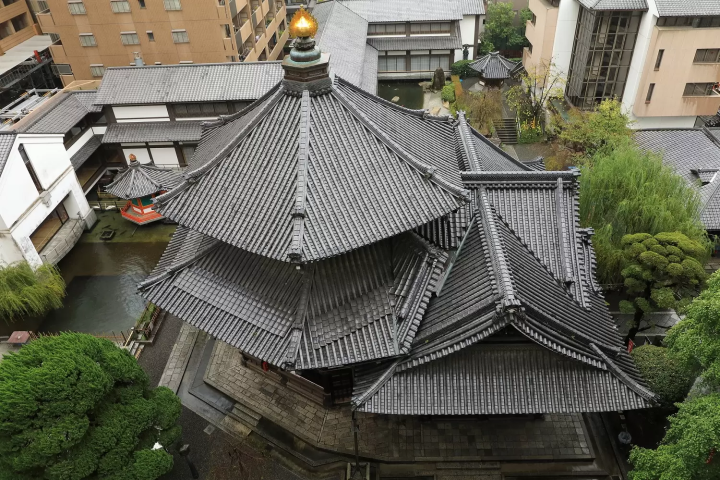
Photo by Pixta
Officially called Shiunzan Chohoji, the temple is known as Rokkakudo due to the hexagonal roof of its main hall.
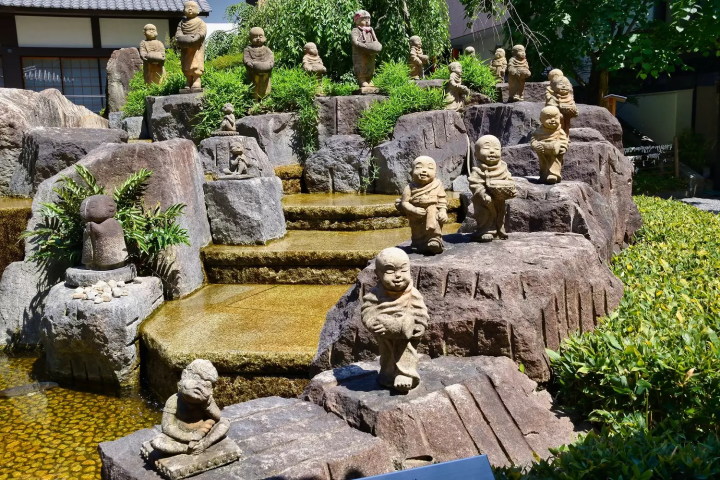
Photo by Pixta
Over the centuries, the monks at Rokkakudo were called "ike-no-bo" because their living quarters were located by the pond ("ike") within the temple precincts. As a result, the head priests of Rokkakudo adopted the name Ikenobo, by which they are known in historical records.
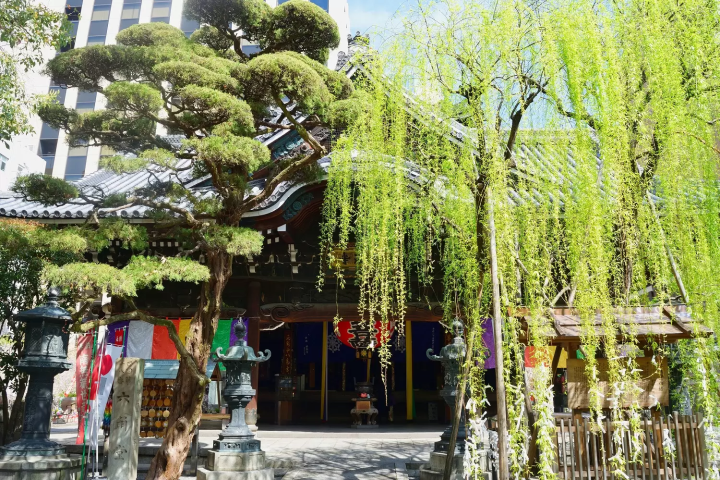
Photo by Pixta
Rokkakudo Temple has served as the headquarters of the Ikenobo School ever since its establishment. To this day, the first ikebana ceremony of the year is held at the main hall of Rokkakudo Temple. During this public ceremony, the Ikenobo headmaster creates an arrangement before the Buddhist altar, which is offered to the deities along with prayers for the New Year.
Currently, a modern high-rise building adjacent to the temple houses the Ikenobo Headquarters. At the Ikenobo Museum, located on the third floor of the facility, visitors can explore historical documents and artifacts related to ikebana and Rokkakudo Temple.
The museum can be visited without prior reservation only during the Spring Ikebana Exhibition (March) and the Autumn Ikebana Exhibition (November) organized by the Ikenobo School in Kyoto.
To visit the museum outside the ikebana exhibition periods, a prior reservation is required via email at kengaku@ikenobo.jp (*please mention your name, the number of people in your group, the date and time you wish to visit, and your mobile phone number).
Rokkakudo Temple
Location: Kyoto, Nakagyo ward, Donomae-cho 248
Hours: 6:00 - 17:00
Website: http://www.ikenobo.jp/rokkakudo/
Ikebana in the Muromachi Period (1336-1573)
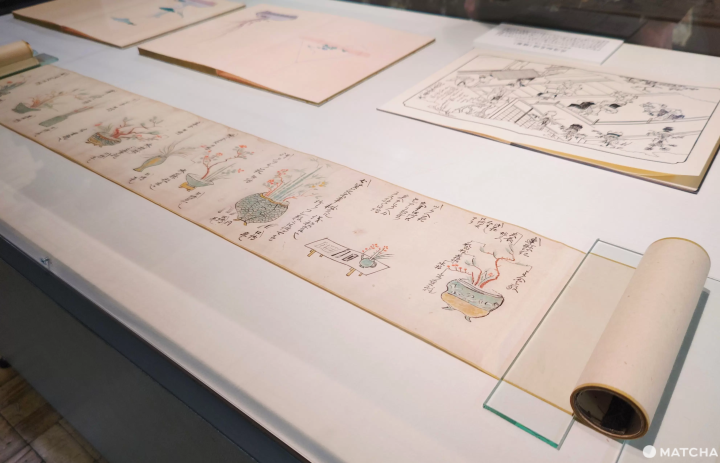
A replica of "Kao irai no kadensho" (1499) exhibited at an Ikenobo ikebana exhibition in Tokyo (May 2023)
By the late 14th century, events known as hana-awase were held around Kyoto. These were exhibitions of flower arrangements hosted at the residences of nobles and high-ranking military officials.
The earliest illustrated document attesting to a hana-awase is the Kao irai no kadensho from 1499, which offers glimpses into the floral arrangements that were in vogue at that time.
The creators of these flower arrangements were the doboshu, unofficial art advisors serving the shogun (*3). Although they often wore priestly attire, the doboshu were typically not directly affiliated with temples but possessed knowledge of Buddhism or expertise in a particular field.
The Ashikaga shoguns in power at the time were known as patrons of the arts; Noh theater, tea ceremony, floral arrangement, garden design, and other arts flourished under their patronage. Concurrently, they developed diplomatic relations with the Ming Dynasty, which led to the import of Chinese wares and art objects.
The doboshu assisted in evaluating these artifacts and devising ways to integrate them into the lifestyles of the shogun and the nobles. Finding the optimal way to arrange flowers in a beautiful Ming vase or determining how to use a precious tea bowl were tasks they undertook.
A priest's diary entry from October 1462 (*4) mentions that a chrysanthemum arrangement created by Ikenobo Senkei for a memorial ceremony deeply moved the hearts of all those who saw it. Senkei was praised for having a truly original and sophisticated approach to arranging the flowers.
The art of the Ikenobo priests rivaled that of the doboshu. In fact, in the early 16th century, Ikenobo Senno criticized the doboshu for their lack of method and philosophy. At the same time, he began theorizing the principles of the flower art practiced by the Ikenobo priests.
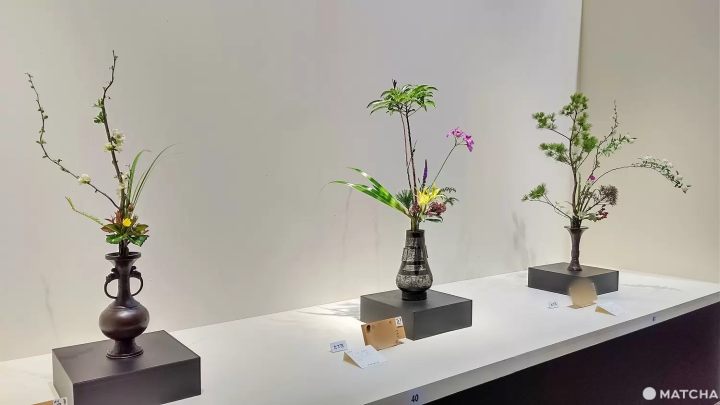
Tatehana-style ikebana at the Spring Ikenobo Ikebana Exhibition in Tokyo, March 2022
The type of flower arrangement practiced by Ikenobo in the 16th century was tatehana, which originated from the flowers brought as offerings on Buddhist altars. In tatehana, the flowers are arranged upright in bronze vases and held in place with straw.
The upright position of the flowers in tatehana is viewed as an axis connecting the earth with the sky and is associated with the prayers that link the human world to the deities.
Ikebana in the Late 16th Century
The 16th century in Japan was marked by civil war. Nonetheless, the powerful lords of the time continued to sponsor the arts. The tea ceremony, ikebana, and Noh theater, in particular, experienced remarkable developments during this period.
Against the backdrop of conflicts and feudal rivalry, those who engaged in these arts did so with a sense of urgency, as if it were a matter of life and death.
During the rule of Toyotomi Hideyoshi, which lasted from 1582 until his death in 1598, the aesthetics of ikebana underwent significant changes. Hideyoshi favored lavishness and opulence, and his tastes profoundly influenced all the arts of the time. In contrast to the austere wabi-sabi aesthetics of the tea ceremony, he ordered the creation of a golden tea room for himself, featuring walls covered in gold leaf and all the tea utensils made of gold.
Recreation of the 1594 sunamono rikka-style created by Ikenobo Senko for lord Hideyoshi's visit to the Maeda residence
In ikebana, flower arrangements became increasingly large, often exceeding one meter in height. The ikebana masters of the time began using tree branches with beautiful shapes. Any household with some wealth and social status would have members learning the art of flower arrangement.
These new aesthetics reached their pinnacle in 1595 when Ikenobo Senko created an impressive sunamono (*) arrangement with pine branches ahead of Lord Hideyoshi's visit to the Maeda residence; the work exceeded 7 meters in diameter. It featured a backdrop of calligraphy with illustrations of monkeys, creating the illusion that the monkeys were sitting on the pine branches.
The work was controversial because Hideyoshi was nicknamed "Monkey" due to his impulsive character and eccentric tastes. Yet, the arrangement was exquisite, surpassing anything that had been done before, and it appealed to Hideyoshi's preferences so much that Ikenobo Senko got away unscathed.
The 1594 sunamono work by Ikenobo Senko at the Maeda residence was recreated in 2012 for the Ikenobo exhibition celebrating 550 years since the establishment of the school. You can see a photo of this recreation on the Ikenobo website.
*Sunamono: A type of large rikka-style ikebana created in a container filled with sand (suna) and pebbles for balance. Sunamono arrangements utilize tree branches and often measure several meters in diameter.
Today's Ikebana
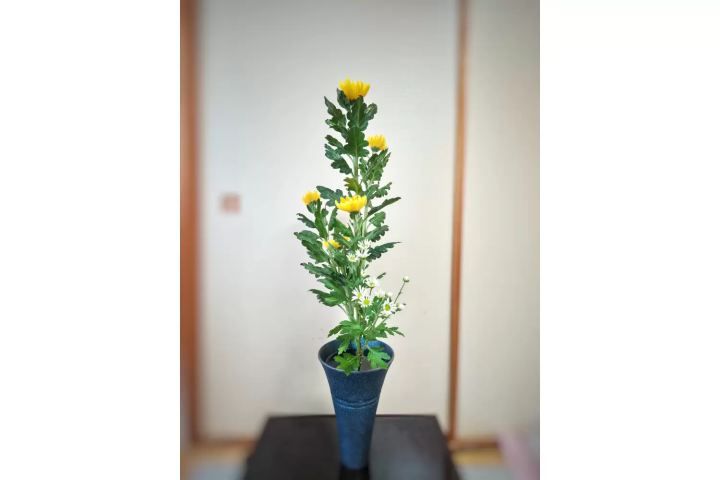
Shoka-style ikebana with chrysanthemums
Chrysanthemums are the highlight of October in ikebana. As the flower featured on the imperial crest, chrysanthemums are revered and hold a very special place in Japanese culture.
When working on a shoka-style arrangement with chrysanthemums, special attention needs to be paid to the leaves, which are just as important as the blooms. The flowers should look dignified; therefore, the leaves should not be removed unless absolutely necessary. A rich amount of leaves on the stems contributes to the elegant appearance of chrysanthemums.
References
1. History of Ikebana Ikenobo, by Ikenobo Masashi, Nihonkadosha, 2016.
2. Ikenobo and the Rokkakudo Temple - Birthplace of Ikebana (retrieved on Oct. 11, 2024)
3. Japanese Garden Dictionary: A Glossary for Japanese Gardens and Their History: Doboshu (retrieved on Oct. 17, 2024)
4. Hekizan Nichiroku, the diary of Zen monk Unzen Taigyoku from Tofukuji Temple. Source: History of Ikebana Ikenobo
Ramona, English content editor at MATCHA since 2016, has been practicing ikebana flower arrangement (Ikenobo School) and tea ceremony (Omote Senke) since 2012. She arrived in Japan in 2012 as a graduate student with a focus on Japanese literature and performing arts. As a travel editor and writer, Ramona has visited and documented 40 of Japan's prefectures with a focus on art, history, traditional Japanese crafts, and performing arts.






































![[Coupon Available] Attention Overseas Winter Sports Fans! Nagano's Sports Depot Has Evolved](https://resources.matcha-jp.com/resize/720x2000/2026/01/05-254819.webp)